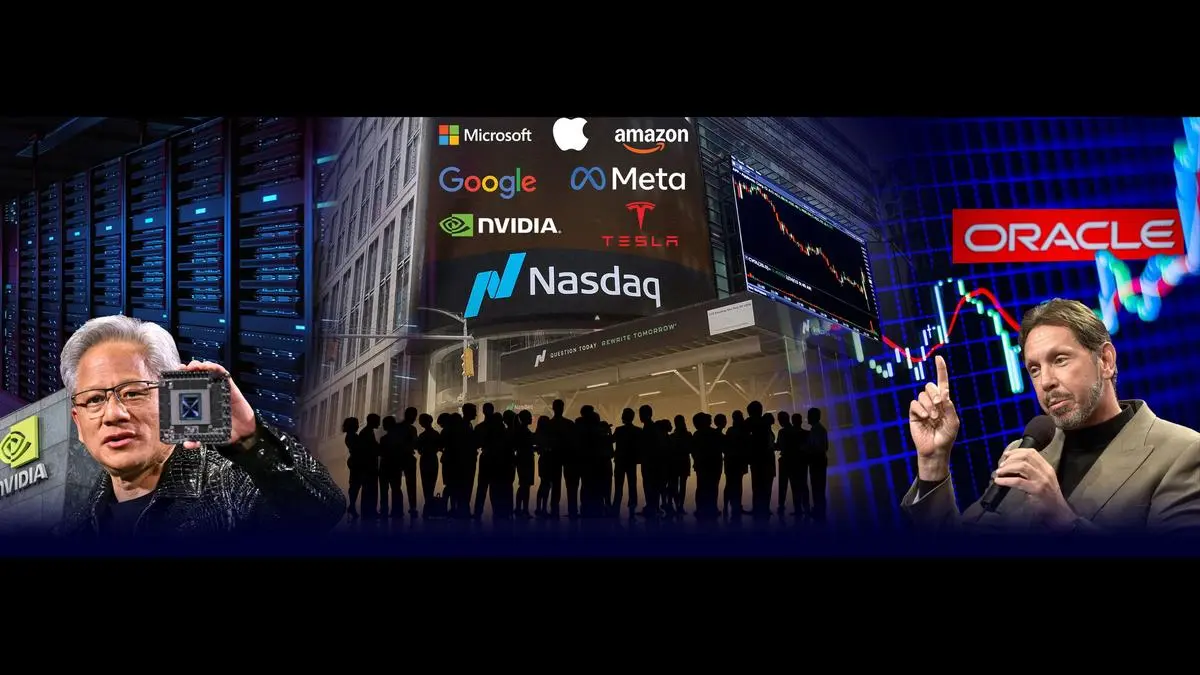One Big Beautiful Bubble: Oracle, Amazon, Microsoft, Google, Meta Platforms, Palantir et al in the danger zone?
By Nishanth
Copyright thehindubusinessline

If Nifty50’s market cap shoots up 10 per cent in a day, it would gain around $225 billion. Compare this to a single stock – Oracle Corporation adding $255 billion to its market cap within few hours on September 10! The message from investors is clear: The AI mania is running up and strong.
The software giant grabbed headlines when its shares gained 36 per cent on September 10. With this massive move up, the stock added over $255 billion to its market cap – joining the exclusive club of stocks that have gained $250 billion or more in a single day. Other members of the coveted club are Nvidia, Apple and Microsoft.
What triggered this euphoria in Oracle shares? The company had reported results for Q1 FY26 on September 9 after market close. However, it wasn’t earnings that pleased the street. While its net profit came in line with expectations, revenue reported a slight miss. What, in fact, surprised the street was the company’s grand plans for scaling up its cloud infrastructure business, a whopping 14 times by FY30 – from $10.2 billion in revenue in FY25 to $144 billion. In other words, this is a compounded growth rate of 70 per cent between FY25 and FY30.
As the AI race continues full steam, it appears Oracle doesn’t want to be left behind. With large language models (LLMs) being built and upgraded left, right and centre, there is heavy demand for data centres that have the compute (processing power) to support this. This is exactly where Oracle and its cloud infrastructure business come in. The company offers cloud-based compute, storage and networking services to clients. Simply put, clients can make use of Oracle’s high-performance cloud servers to deploy applications based on AI.
During the said quarter, the company signed multiple multi-year, multi-billion-dollar contracts (largely under the cloud infrastructure vertical), taking the RPO (remaining performance obligations) figure to $455 billion, which is all the more the main reason for the rally. Readers can understand RPO as order backlog for now. This is a rise of 359 per cent year on year and 230 per cent quarter on quarter. RPO is further expected to reach $500 billion in the next few months. For context, Oracle’s FY25 revenue was $57.4 billion.
Investors jumping the gun?
Though the company is making the right moves to make the most of AI-led demand, there are a few factors that are noteworthy here. First, RPOs represent contracted revenue that is yet to be recognised. Revenue can be recognised only if Oracle could discharge its contractual obligations when the time comes. Thus the $455-billion RPO is not an absolute guarantee that it would translate to future revenue. Contract cancellations and unfavourable modifications to the contract terms could result in material write-down of RPOs.
Second, Wall Street Journal reported that Oracle has struck a $300-billion deal with OpenAI, likely spanning over five years from 2027. Now, looking at this in tandem with the $455-billion RPO figure, it leads one to believe that much of the future revenue is tied to one single client – giving room for concentration risk. What is even more concerning is the fact that OpenAI is a cash-burning start-up, run on venture capital, with about $10 billion in annual recurring revenue, per media reports.
Third, while the company appears to have a robust road-map for the cloud infrastructure business, there isn’t relatively as much clarity as to the future of the rest of the businesses. Currently, the cloud infrastructure business accounts for just 17 per cent of overall revenue based on FY25. In the last five quarters, this vertical has clocked year-on-year constant currency revenue growth of 51 per cent on average. This, while the rest of the verticals have grown at a mere 2.5 per cent.
While such concerns linger, the market’s reaction appears premature and running ahead of fundamentals. Even in the last five years, the company’s execution record has not been strong relative to its stock price performance.
On an absolute basis, while earnings have grown 23 per cent on an absolute basis over that of FY20, stock price during the same period has risen close to 400 per cent. Even before the 36 per cent jump last week, the stock was trading at a trailing PE of 54x, which is not inexpensive. As of September 19, it trades at a PE of 69x.
All things considered, this very simply reflects investors’ euphoric bet on anything linked to AI. But is it turning into a bubble, one that is reminiscent of the dotcom bust?
Economics of the AI race
Before addressing the pertinent question, investors first need to understand the sheer size of economic interest involved in the ongoing AI race.
Here’s some crazy statistic. Since January 2020, the market cap of the S&P 500 index has risen $31 trillion. On another hand, the top 10 AI stocks, that are part of the index, have added $18 trillion to their combined market cap. These include Nvidia, Microsoft, Apple, Alphabet, Amazon, Meta, Tesla, Oracle, Broadcom and Palantir.
This is saying, the worth of just 2 per cent of the index’s stocks have grown equivalent to 60 per cent of the index’s gains, while the rest 98 per cent got the short end of the stick (40 per cent). Also, currently, the market cap of these stocks put together is as large as 40 per cent of S&P 500’s market cap.
Further, the current AI surge demands unprecedented capital expenditure, as companies compete to build the computational infrastructure. These include real estate for data centres, the cutting-edge GPUs and related cooling systems and network hardware. In the past few years, Amazon, Microsoft, Alphabet, Meta and Oracle (in descending order of quantum of capex; referred to as Big 5 in this article) have been large spenders on capex. Together, the Big 5 have invested an aggregate of $586 billion over the last three fiscals. They are expected to incur about $860 billion in the next two years. This is almost as big as how much the US spends on defence every year.
Historically, the Big 5 have been asset-light businesses. However, with capex picking up lately, their combined fixed assets turnover ratio (only tangible assets considered) has gradually declined year on year to almost half of what it was 10 years ago — from 4.6 times to 2.2 times now.
To put it in perspective, if one were to assign the multiple of 4.6x to the capex expected to be incurred in 2025 – about $400 billion (see chart), the expectation is that there should be an incremental revenue of $1,850 billion. However, the combined revenue of the Big 5 in the recently-concluded fiscal was only about $1,500 billion and it has taken decades since these companies were incorporated to reach such a scale. Even at the lower end of the multiple – at 2.2 times, incremental revenue required out of the capex would work out to $880 billion by end of FY25. For context, the combined revenue of the cloud verticals of the Big 5 is just about $250 billion today. Even if one were to assume that incremental revenue will kick in with a lag, the argument does come across as a hard sell, especially with these figures.
Tech capex drives GDP
Another statistic that brings out how big the AI capex has become for the economy is the one from the US’ Bureau of Economic Analysis. It measures the contribution of segments of the economy to the overall GDP every quarter. For example, if the GDP growth (real) rate during the quarter is 3 per cent and the contribution of personal consumption expenditure (PCE) reads 1 per cent, then it means that PCE has contributed to a third of incremental GDP.
Similarly, for the recently-concluded quarter (Q2 2025), GDP growth was 3.3 per cent, but contribution of gross private domestic investment came in at -2.7 per cent. However, contribution of investment in information processing equipment and software (tech capex), which form part of gross private domestic investment, stood at 0.8 per cent.
This shows that despite a slowdown in the overall private capex in the economy, tech capex has stood resilient. For lack of further detailed classification, information processing equipment and software have been considered here, which can be safely assumed to be substantially driven by the ongoing AI, data centre capex.
If one were to construct a two-quarter moving average line of this contribution to GDP measure, in the recent quarter, the contribution of tech capex to GDP (1.1 per cent) has, in fact, surpassed the contribution of PCE to GDP (0.7 per cent) for the first time, in the quarters analysed since 2022. This is big, especially when you consider the fact that PCE accounts for about 70 per cent of US’ GDP.
No room for error
Considering the above pointers, it is quite clear that the AI mania is now just too big to fail. Whether it is the wealth effect and its consequent positive impact on economic growth or their hard capex driving a good chunk of the economy or the investor sentiment riding upon these companies, it is in the best interest of all stakeholders that expected revenues start flowing in.
Looking ahead, AI is still an evolving technology and so, the picture looks murky today. One, there isn’t yet concrete evidence proving efficiency gains from use of AI would be attractive and cost effective enough to drive healthy adoption in enterprises. Two, while LLMs are being trained by spending on bleeding edge GPUs, there are noticeable positive developments with smaller models that wouldn’t require as much compute as LLMs, sometimes possible even without GPUs – raising the question as to what is the right level of capex.
Three, today broadly AI is being used in applications such as summarisation, generative media, transcription and others – where the AI models do not appear to stand differentiated from one another. Sure, AI has found use-cases such as support services, pharmaceutical research and so on. However, the single most important application for AI in the next decade – which could be robotics or autonomous driving, for example, are not yet on the horizon when it comes to mass deployment.
On considering the above, the valuations of top AI stocks today are not cheap, with all except Nvidia and Amazon trading at PE ratios above five-year averages. Palantir’s market cap is $433 billion, while its revenue is just $2.9 billion. Outside the top 10, stocks like AMD, ARM Holdings trade at PE ratios of 86x and 172x respectively. CoreWeave, a recently-listed cloud services company, is yet to turn profitable but is a $61-billion unit, with revenue and net loss of $1.9 billion and $863 million (FY24).
In the unlisted space, AI start-ups are raking in capital from VC/PE funds at lofty valuations. Entities from within the AI value chain have become backers in some cases. Case in point, Microsoft’s, Amazon’s and ASML’s investment in OpenAI, Anthropic and Mistral respectively. All three are cash-burning start-ups valued at about $300 billion, $180 billion and $14 billion respectively (per known latest funding rounds).
This exuberance does make one reminiscent of the infamous dotcom bubble of 2000 – when anything that had ‘Internet’ stamped on it was selling like hot cakes, even at unreasonable valuations.
Right before the bubble burst in March 2000, the S&P 500 reached a PE ratio of 29.5x – never to see a rerating to such levels until April 2021, which too lasted only briefly. Today, its PE is reasonably close to such levels at 26x. However, the current market cap (of S&P 500) to GDP ratio stands at 2x, much worse than about 1.3x in March 2000. Even on a forward earnings basis, the index and almost all top AI stocks trade at PEG (price to earnings growth) ratios of over 2x, which appear unsustainable, all things considered.
Though AI presents a structural opportunity to bet on, investors need to be extremely watchful of valuations as they can make all the difference. Investors will be better served waiting for now, in search of better entry points with higher margin of safety.
As the AI craze continues to heat up, it is worth pondering on this quote from John Hussman, a fund manager who was prescient in his prediction of the dot com crash: Valuations often matter suddenly, and with a vengeance. This is a lesson best learnt before a crash rather than after one.
In the interest of how much depends on AI investment and wealth effect, one will have to hope this time is truly different!
Published on September 20, 2025



